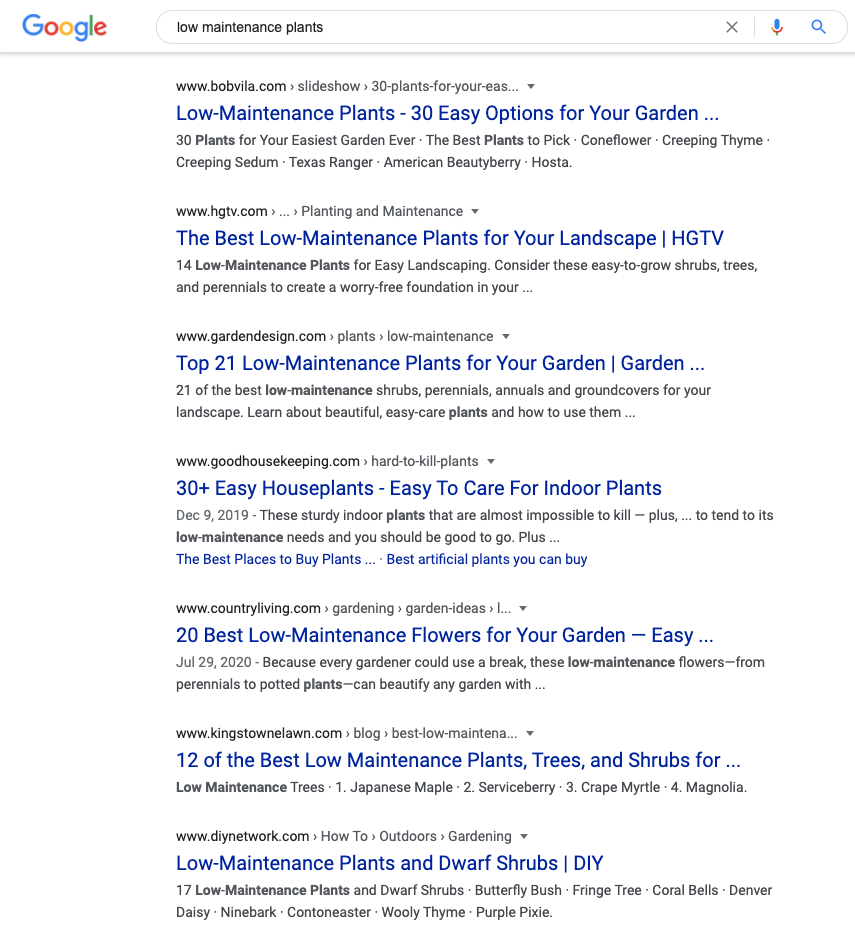Using Segmentation to Improve Sponsorships & Activations
What do you think of when you hear the phrase “diverse sponsorships?”
9 min read
Paul Morris
:
Sep 15, 2020 5:27:00 PM

In part one of Overhauling Your Website’s SEO Content Strategy we showed you how to take inventory of your content and what to pay attention to when determining your website structure. In this post, we’ll show you how to optimize your existing content and plan for optimized content in the future.
At this point, you should have created your content outline and your master list of headings, titles, URLs, and descriptions. Using this information, you’ll make incremental changes to your site’s structure and content with the goal of telling Google two things:
To reach that goal, you need to determine what keywords each of your pages should be ranking for.
You’ve almost certainly heard of keywords in the context of SEO and their importance to the topic. Whether you have heard of them or not, Google has been determining what each of your page’s keywords are based on the content, heading, title tag, and URL (among other factors). Google does not use the meta description to determine a page’s keywords, but more on that later.
Without going into too much detail, keywords are simply just search terms that people type when they try to find things on the internet. Google decides what your pages’ keywords are based on the previously mentioned elements and then may show your site in search results for those keywords when they are searched for. Put simply, they are searchable topics associated with a page.
If you haven’t put much thought into what keywords you are trying to rank for, you can see how Google might have misconceptions about your pages. Regardless of how sophisticated a search engine’s algorithms are, they still rely on a basic set of rules to determine how someone should find your content. Even if any human could read your case study titled “Creating a Logo for Big Smiles Dentistry” and understand that it’s about logo design, Google might think this page is all about “Big Smiles Dentistry” if you don’t point it in the right direction.
As previously mentioned, Google is already deciding on what keywords your pages are ranking for based on content and attributes such as a page’s title tag. To see what these keywords are, you can look through the data collected in the Performance section for your website in Google Search Console. If you have not already created and verified a website property in Google Search Console for your site, you should do so now. Unfortunately, it will take some time for Google to begin reporting on your property if it was just set up, so you may need to wait several days before you begin seeing any relevant data.
With your website property set up in Search Console, you should be able to view queries (i.e., keywords typed into Google) people have made that resulted in a particular page showing up in search results. The next step is to answer the following question for each of your pages: Does it make sense for this page to rank for the listed keywords?
In some cases, you’ll be able to answer the above question without much trouble. For example, a listicle blog post you wrote about your top 10 easy-to-care-for houseplants is ranking for the keyword “low maintenance plants.” Great! Google clearly understands what you were writing about when it crawled and indexed your content. But what if you’re not sure about the keyword a page is ranking for?
Instead of “low maintenance plants,” let’s say your listicle’s highest ranking keyword is “home gardening.” This doesn’t seem wildly off-base, but it should give you pause. Your post definitely falls under the category of home gardening, but the term is a little generalized. Specificity can help better direct people to the content they’re looking for, and your post might get lost in the mix of “home gardening” search results.
We can test if a keyword makes sense and is specific enough for a page easily. Just type the keyword in question into Google and see what comes up. Sticking with our previous example, here’s what shows up for “low maintenance plants”:

All of these results are similar to our post. It would make sense for it to show up in this list because, clearly, this kind of article is what people are looking for when they search “low maintenance plants.” Knowing this, you can feel confident that your post is ranking for the right keywords. What about the results for “home gardening?”

The pages in these results are not very similar to your post. It seems that when people search “home gardening,” they are looking for information about starting vegetable gardens, not lists of easy-to-care-for plants. This lets us know that “home gardening” is not an appropriate keyword for this post, and that your post will likely never rank well for that term.
When starting out, perform this “smell test” on all of the keywords your pages are already ranking for. It will let you know if a page could be ranking higher for a more specific search term.
So what can you do to suggest better keywords for your pages to Google?
After identifying a page that is ranking for less-than-ideal keywords, your goal is to optimize important elements on the page so that it ranks for more appropriate keywords. This is where your master list of SEO page attributes is going to come in handy. Look through your master list for the page’s heading and title tag. Our example listicle which is ranking for “home gardening” has the following:
Page heading: No-Stress Home Gardening
Title tag: Plant Care Made Easy | Home Gardening Blog
To help get this page ranking for the more appropriate “low maintenance plants” keyword, both of these will need to be re-written. The following would be a step in right direction:
Page heading: 10 Low Maintenance Plants for your Home
Title tag: 10 Low Maintenance Plants for your Home | Home Gardening Blog
In Google’s view, this page heading and title tag removes the emphasis on the phrase “home gardening.” We’ve left it in the tail-end of the title tag since it is the name of our blog, but now “low maintenance plants” is near the beginning of the tag. The title tag is also nearly identical to the page heading. This is common practice, and it makes sense from a user perspective; if you visit a page because you read the title tag in search results, you will expect a similar heading once you reach the page.
Make sure that you update your catalog of page attributes with your optimizations when you update a page’s title tag and heading. This list should stay current with all the changes you make so you can reference it when planning future content.
Even if you’ve optimized your page heading and title tag, it still may not rank well for the desired keywords. That’s because the keyword you want to rank for needs to appear in the content of the page as well. There is no hard and fast rule for how often your keyword should appear in your page content. The ideal percentage of keywords to word count is not something that search engines make public, so instead we have to rely on best practices and some discretion.
One thing we do know is that Google hates keyword stuffing. Keyword stuffing is “the practice of loading a webpage with keywords or numbers in an attempt to manipulate a site's ranking in Google search results,” per Google’s quality guidelines. This still doesn’t tell us how many instances of a keyword is too many, but Google does offer some wonderful advice:
“Focus on creating useful, information-rich content that uses keywords appropriately and in context.”
It’s pretty simple -- if it feels like you are cheating by repeatedly forcing your keyword into your content, then you probably are. Either you are using your keyword too much (in this case, replace some instances with synonyms), or your page just doesn’t cover that topic. If you find yourself in the latter situation, you’ve likely just picked the wrong keyword to rank for. Go back and perform our smell test for the keyword in question and try to identify a more appropriate search term to rank for.
With that being said, most experts in the field believe that the ideal keyword density for a page is 1-2%. In other words, your keyword should appear once or twice per every 100 words. Keep in mind that you are trying to present useful, information-rich content; if you are annoyed by reading the same keyword over and over again in a post, others will be as well and they won’t find your content very useful.
If you have spent time optimizing content that you’ve already created, you’ve learned many of the skills that you need for optimizing future content. However, you now have the added benefit of being able to plan your approach instead of working backwards from pages that are already indexed by Google. You also now have two very useful documents: a website content outline and an updated list or spreadsheet of your pages’ headings, title tags, meta descriptions, and URLs.
Your website content outline should give you a clear idea of how to organize future pages. Your top-level pages should provide you with general categories that you can nest future sub-pages under. If you have an idea for a new page and it doesn’t seem to fit underneath any of these categories, there are several questions you can ask yourself to determine how to move forward:
Your outline should help you envision where your new page should go in your site’s navigation, as well its overall purpose in the context of your site. Its purpose is to make you consciously choose where your content belongs instead of just adding another link to your top-level navigation. It is a visual representation of your site’s information hierarchy, and new pages should fit neatly into that hierarchy. If they do not, your hierarchy may need to be reorganized, or you may need to consider if your proposed new page has relevance to your site.
Keyword research is essential to optimizing future content on your site. It’s also an enormous topic that would be difficult to cover here in its entirety. Fortunately, you’ve already done a part of the keyword research process by cataloging all of your pages’ attributes. If you’ve tried our smell test by Googling keywords you want to rank for, then you’ve performed another simple yet effective method of keyword research.
Your catalog of page attributes is important because it gives you a high-level look at the topics you explore on your site. While you might not have been able to see the forest for the trees just looking through your website, it should now be easier to see what topics might be missing just by looking at what you’ve already covered.
You can also avoid something called keyword cannibalization by using your page list. Have an idea for a new page? Look through your page headings and title tags and see if you’ve already created similar content. Creating pages that are too similar can cause them to compete against each other for the same keywords, meaning you’re hurting your own chances of ranking well.
Once you feel confident that your proposed page won’t overlap with your existing content, you can use the smell test to help determine what keywords the page should rank for. Think about what you would search in Google if you wanted to find a page like the one you’ve proposed. Look at the results that come up when you Google that phrase. Would your new page fit in with those results, or would it be out of place?
To see how well your optimizations and new pages are doing, you’ll need to monitor your search performance over time. Your goal for each of your pages is to see an increase in impressions, page position, and clicks for your desired keywords. Google provides plenty of documentation on running reports that show how your web traffic is changing over time.
Low impressions, ranking, and click-through rates will mean that Google isn’t finding your content useful and informative. That usually means that visitors will feel the same way. If you find yourself wondering why your optimizations aren’t working as expected, ask yourself the following questions:
Using the tools provided in this series, you should be able to answer these questions and adjust accordingly. Unfortunately, there are times when it seems that you’ve done everything right and your pages still aren’t ranking well. Sometimes, patience may be the answer. It takes time for Google to notice changes you make. Favoring a month-to-month or quarter-to-quarter approach to reporting will tell you more than looking at your rankings week-to-week.
SEO is a lot of work. The research and on-site optimizations take up a lot of time, and seeing your efforts pay off can take even longer. There is also a staggering amount of best practices to learn and keep up with (Google changes their algorithms from time to time). In fact, we’ve barely scratched the surface of SEO as a topic.
Once you start to see an increase in traffic to your site, you should feel inspired to continue learning about things like page speed, canonicalization, backlinks, and rich snippets. Diving into these topics will help you continue to improve your website and increase your page ranking. Maybe you’ll even be able to rank on the coveted first page of search results if you’re diligent enough!
All that aside, remember that content is at the core of SEO. If your site is doing poorly on search, your content and its organization is probably the reason why. Overhauling your SEO content strategy and putting a plan in place for the future will get you back on track and drive more traffic to your website. People are probably out there searching for your content right now -- you just have to help them find it!

What do you think of when you hear the phrase “diverse sponsorships?”

Come June,we can expect to see the usual suspects up in arms about brands engaging in (or even supporting) LGBTQ+ Pride campaigns. Of course, not...

First things first: what is a podcast?